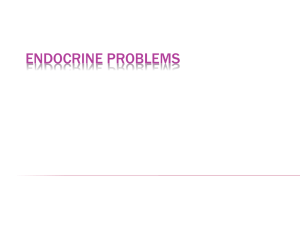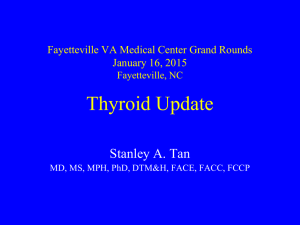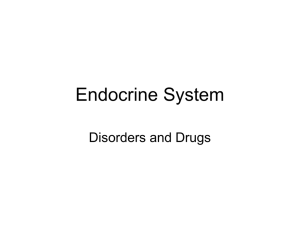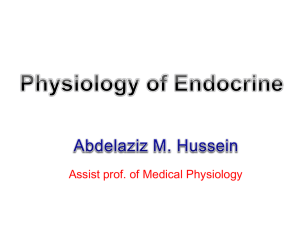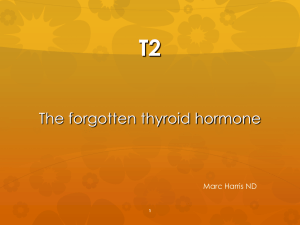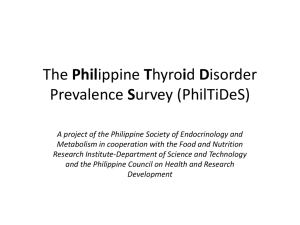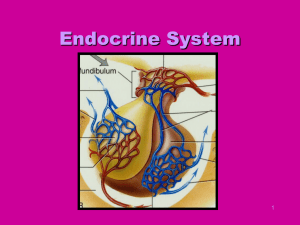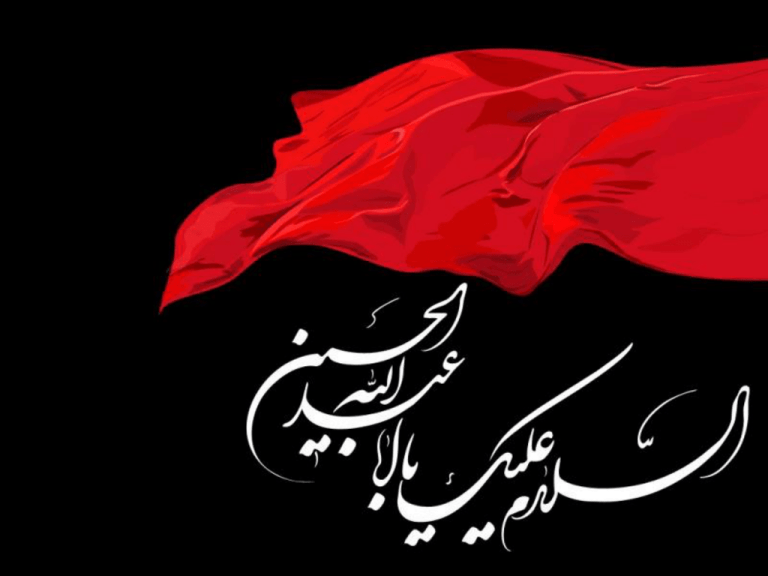
LOGO
LOGO
THE THYROID GLAND
OVER TRACHEA
TWO LARGE LATERAL LOBES CONNECTED
BY AN ISTHMUS
15 to 20 g
FUNCTIONAL UNIT IS THE FOLLICLE:
EPITHELIAL CELLS AROUND A HOLLOW
VESSICLE FILLED WITH THYROGLOBULIN
Anatomy
Biosynthesis, Secretion, And Transport of
Thyroid hormones
Iodine is the most important element in the biosynthesis of
thyroid hormones.
Thyroglobulin acts as a performed matrix containing tyrosyl
groups to which the reactive iodine attaches to form the
hydroxyl residues of monoiodotyrosine (MIT) and diiodotyrosine
(DIT).
The coupling of two DIT molecules forms T4 .
The coupling of one DIT molecules and one MIT molecule
results in the formation of T3 or reverse T3 (rT3)
Almost all circulating T4 and T3 hormones are bound to serum
proteins ( thyroid hormone-binding proteins )
Thyroid Hormone Synthesis
1. Iodide trapping
2. Oxidation of iodide and iodination of
thyroglobulin
3. Coupling of iodotyrosine molecules within
thyroglobulin (formation of T3 and T4)
4. Proteolysis of thyroglobulin
5. Deiodination of iodotyrosines
6. Intrathyroidal deiodination of T4 to T3
Only 0.03 % of T4 and 0.3 % of T3 are not bound to
proteins . These fractions, called free T4 (FT4) and
free T3 (FT3), are the physiologically active portions of
the thyroid hormones .
T3 is the most biologically active thyroid hormone and
is three to four times more potent than T4.
T3 is more active because it is not as tightly bound to
the serum proteins as is T4, and has a greater affinity to
target tissue receptors
Hypothalamic Pituitary Axis
Evaluation
Thyroid function tests
TSH :
The single most sensitive, specific and reliable test of thyroid status .
In primary hypothyroidism, [TSH] is increased.
In primary hyperthyroidism, [TSH] is decrease or undetectable
Total T4 and Total T3 :
More than 99% of T4 and T3 circulate in plasma bound to protein
Both [total T4] and [total T3] change if [TBG] alters, e.g. in
pregnancy
Free T4 and Free T3
Free thyroid hormone concentrations are independent
of
changes in the concentration of thyroid-hormone binding proteins →
more reliable for diagnosis of
thyroid dysfunction
Interpreting results of thyroid
function tests
Primary hyperthyroidism
Plasma [TSH] : ↓ due to feedback
inhibition on the pituitary
Plasma free and total T4 and T3
concentrations : ↑
Primary hypothyroidism:
Plasma [TSH] :
↑
Plasma [free T4] and [total T4] :
↓
Plasma free T3 and total T3 measurements
are of no value here, since normal
concentrations are often observed .
Physical Exam
Evaluation of the Thyroid
Disease(Ultrasonography)
Most sensitive procedure or identifying lesions
in the thyroid (2-3mm)
90% accuracy in categorizing nodules as solid,
cystic, or mixed (Rojeski, 1985)
Best method of determining the volume of a
nodule (Rojeski, 1985)
Can detect the presence of lymph node
enlargement and calcifications
Noninvasive and inexpensive
Evaluation of the Thyroid Disease
(Radioisotope Scanning)
Prior to FNA, was the initial diagnostic procedure
of choice
Performed with: technetium 99m pertechnetate or
radioactive iodine
• Technetium 99m pertechnetate
»
»
»
»
cost-effective
readily available
short half-life
trapped but not organified by the thyroid - cannot
determine functionality of a nodule
Normal scan of thyroid gland
Graves – Basedow disease
Autonomous adenoma
Initial scan - euthyreosis
Repeat scan - hyperhyreosis
Cold nodule
(Fine-Needle Aspiration) Evaluation
of the Thyroid Disease
Currently considered to be the best first-line
diagnostic procedure in the evaluation of the
thyroid nodule:
Advantages:
•
•
•
•
Safe
Cost-effective
Minimally invasive
Leads to better selection of patients for surgery than any
other test (Rojeski, 1985)
Effects of Thyroid Hormone
Fetal brain and skeletal maturation
Increase in basal metabolic rate
Inotropic and chronotropic effects on heart
Increases sensitivity to catecholamines
Stimulates gut motility
Increase bone turnover
Increase in serum glucose, decrease in serum
cholesterol
Goiterogenesis
Iodine deficiency results in hypothyroidism
Increasing TSH causes hypertrophy of thyroid
(diffuse nontoxic goiter)
Follicles may become autonomous; certain follicles
will have greater intrinsic growth and functional
capability (mult inodular goiter)
Follicles continue to grow and function despite
decreasing TSH (toxic mul tinodular goiter)
Sporadic vs. endemic goiter
Simple (Colloid) Goiter
Diffuse goiter
Usually euthyroid
Peaks in puberty
Endemic goiter
Compensatory TSH
Follicular cell hypertrophy and
hyperplasia
Goiterogens (eg, cassava)
Non endemic or sporadic less
common
Rare hereditary defects in
thyroid hormone synthesis
Note distension of follicles with colloid
and flattening of epithelial cells
Multinodular Goiter
Most simple goiters become transformed into
multinodular goiters.
Nontoxic or toxic (induce thyrotoxicosis)
No ophthalmopathy or dermopathy
May cause cosmetic disfigurement and tracheal
compression
May induce the superior vena caval syndrome
Differentiation of a dominant nodule from a thyroid
tumour may be difficult.
Retrosternal extension
33
34
Presentation
Usually picked up on routine physical exam
or as incidental finding
Patients may have clinical or subclinical
thyrotoxicosis
Patients may have compressive symptoms:
tracheal, vascular, esophageal, recurrent
laryngeal nerve
Tracheal Compression
Multinodular Goitre
Note fibrosis and variation of follicular size
Gross and Microscopic Pathology
Multinodular Goiter
Figure 17-5. (A) Cross section of multinodular
goiter. (B) Gross radioautograph of the thyroid
in part a. Observe the variation in 131I uptake
in different areas.
Treatment of Diffuse or Multinodular
Goiter
Suppressive Therapy
Antithyroid Medications: Propylthiouracil
and Methimazole
I-131
Surgical Therapy
Tumours
of
Thyroid
Gland
Tumours of Thyroid Gland
2-4% estimated incidence of palpable solitary nodules.
Most are not neoplastic and 90% of neoplastic nodules
are adenomas.
Thyroid cancer is rare (30 per million per year).
The younger the patient the greater the chance of
neoplasia.
A nodule in a male patient is more suspicious than in a
female.
Thyroid Adenoma
Most are follicular
adenomas
Encapsulated
Homogeneous, soft, fleshy
cut surface
Foci of haemorrhage
Rarely cause
hyperthyroidism
Most are “cold” on isotope
thyroid scan
Cystic degeneration
Malignant Thyroid Tumours
1.
2.
3.
4.
5.
6.
Papillary carcinoma
Follicular carcinoma
Medullary carcinoma
Anaplastic carcinoma
Lymphoma
Tumours metastatic to the thyroid
History
Symptoms
The most common presentation of a thyroid
nodule, benign or malignant, is a painless mass in
the region of the thyroid gland (Goldman, 1996).
Symptoms consistent with malignancy
•
•
•
•
•
•
Pain
dysphagia
Stridor
hemoptysis
rapid enlargement
hoarseness
History (continued...)
Risk factors
Thyroid exposure to irradiation
• low or high dose external irradiation (40-50 Gy [40005000 rad])
• especially in childhood for:
– large thymus, acne, enlarged tonsils, cervical adenitis,
sinusitis, and malignancies
• 30%-50% chance of a thyroid nodule to be malignant
(Goldman, 1996)
History (continued...)
Risk factors (continued…)
Age and Sex
• Benign nodules occur most frequently in women 20-40
years (Campbell, 1989)
• Men have a higher risk of a nodule being malignant
History (continued…)
Family History
History of family member with medullary thyroid
carcinoma
History of family member with other endocrine
abnormalities (parathyroid, adrenals)
Evaluation of the thyroid Nodule
(Physical Exam)
Examination of the thyroid nodule:
• consistency - hard vs. soft
• size - < 4.0 cm
• Multinodular vs. solitary nodule
– multi nodular - 3% chance of malignancy (Goldman, 1996)
– solitary nodule - 5%-12% chance of malignancy
(Goldman, 1996)
• Mobility with swallowing
• Mobility with respect to surrounding tissues
• Well circumscribed vs. ill defined borders
Evaluation of the Thyroid Nodule
(Blood Tests)
Thyroid function tests
• thyroxine (T4)
• triiodothyronin (T3)
• thyroid stimulating hormone (TSH)
Calcitonin
Thyroglobulin (TG)
Serum Calcium
Evaluation of the Thyroid Nodule
(imaging)
Chest radiograph
Computed tomography
Magnetic resonance imaging
Radioimaging usually not used in initial work-up of
a thyroid nodule
Evaluation of the Thyroid Nodule
(Ultrasonography)
Most sensitive procedure or identifying lesions in
the thyroid (2-3mm)
Best method of determining the volume of a
nodule (Rojeski, 1985)
Can detect the presence of lymph node
enlargement and calcifications
Noninvasive and inexpensive
Evaluation of the Thyroid Nodule
(Radioisotope Scanning)
Prior to FNA, was the initial diagnostic procedure
of choice
Evaluation of the Thyroid Nodule
(Fine-Needle Aspiration)
Currently considered to be the best first-line
diagnostic procedure in the evaluation of the
thyroid nodule:
Advantages:
•
•
•
•
Safe
Cost-effective
Minimally invasive
Leads to better selection of patients for surgery than any
other test (Rojeski, 1985)
Fine-Needle Aspiration
(continued…)
FNA halved the number of patients requiring
thyroidectomy (Mazzaferri, 1993)
FNA has double the yield of cancer in those who
do undergo thyroidectomy (Mazzaferri, 1993)
Fine-Needle Aspiration
(continued…)
Pathologic results are categorized as:
• positive,
• negative, or
• indeterminate
Thyroiditis
Chronic Thyroiditis
Also known as Hashimoto’s disease
Probably the most common cause of
hypothyroidism in United States
Autoantibodies include: thyroglobulin antibody,
thyroid peroxidase antibody, TSH receptor
blocking antibody
Gross and Microscopic
Pathology of Chronic
Thyroiditis
Presentation and Course
Painless goiter in a patient who is either
euthyroid or mildly hypothyroid
permanent hypothyroidism
May have periods of thyrotoxicosis
Treat with levothyroxine
Subacute Thyroiditis
Most common cause of thyroid pain and
tenderness
Acute inflammatory disease most likely due to
viral infection
Transient hyperthyroidism followed by transient
hypothyroidism; permanent hypothyroidism or
relapses are uncommon
Subacute thyroiditis
Tc-99m pertechnetate
Treatment of Subacute
Thyroiditis
Symptomatic: NSAIDS or a glucocorticoid
Beta-blockers indicated if there are signs of
thyrotoxicosis
Levothyroxine may be given during hypothyroid
phase
Histopathology of Subacute
Thyroiditis
Riedel’s Thyroiditis
Rare disorder usually affecting middle-aged
women
Likely autoimmune etiology
Fibrous tissue replaces thyroid gland
Patients present with a rapidly enlarging hard
neck mass
Histopathology of Riedel’s
Thyroiditis
ACUTE INFECTIOUS THYROIDITIS
Rare, serious, bacterial
inflammatory disease of the
thyroid.
Protective mechanisms of the thyroid
gland:
very good perfusion
efficient lymphatic drainage
capsulation of the thyroid
high concentration of iodine
Etiologic agents:
Streptococcus pyogenes,
Streptococcus pneumoniae,
Escherichia coli,
Pseudomonas aeruginosa,
Salmonella typhi,
anaerobes of the oropharyngeal
cavity.
RARE FORMS OF INFECTIOUS
THYROIDITIS:
the thyroid is rarely the seat of tuberculosis,
syphilis, fungal infections (Aspergillus
species), or parasites;
Pneumocystis carinii infection of the thyroid
has been reported in patients with AIDS.
TREATMENT OF INFECTIOUS
THYROIDITIS
this type of thyroiditis requires the
administration of appropriate antibiotics
based on the findings of the culture from a
fine-needle aspirate, and surgical drainage
(or excision) of any area of fluctuance or
abscess.
hematogenous seeding
from distant foci
direct
trauma
Infection to the
thyroid occurs by:
extension from
adjacent infected structures
through
a persistent
thyroglossal duct
CLINICAL PICTURE
OF ACUTE INFECTIOUS THYROIDITIS
the skin over the infected area is erythematous and
warm
the white cell count and erythrocyte sedimentation rate
are elevated
thyroid antibodies are absent
serum T4 and T3 levels are usually normal as well as
thyroid RAIU
TREATMENT OF INFECTIOUS
THYROIDITIS
this type of thyroiditis requires the
administration of appropriate antibiotics based
on the findings of the culture from a fine-needle
aspirate, and surgical drainage (or excision) of
any area of fluctuance or abscess.
Drug-Induced Thyroiditis
Patients receiving cytokines such as IFN- or IL2 may develop painless thyroiditis
Amiodarone
Hypothyroidism
Hypothyroidism
Before treatment
After treatment
Hypothyroidism
Clinical syndrome resulting from a deficiency of
thyroid hormones, which in turn results in
generalized slowing down of metabolic processes
Classification of hypothyroidism
Primary (thyroid failure)
Secondary (Central):
pituitary TSH deficit
hypothalamic deficiency
Peripheral resistance to the thyroid hormones
Goitrus
Nongoitrus
Etiology of hypothyroidism
• Primary:
1. Hashimoto’s thyroiditis
A/ with goiter
B /thyroid atrophy
end-stage autoimmune thyroid disease, following either
Hashimoto’s thyroiditis or Graves’ disease
2. Subacute thyroiditis
3. Thyroidectomy or therapy for hyperthyroidism
(drugs, 131I)
4. Excessive iodide intake
5. Other causes
A/ Iodide deficiency
B/ Goitrogens
C/ Inborn errors of thyroid hormone synthesis
Etiology of hypothyroidism
Secondary(Central):
Hypopituitarism due to pituitary adenoma,
pituitary ablative therapy, or pituitary destruction
Hypothalamic destruction
Peripheral resistance to the action of
thyroid hormones
Cretinism
Main features:
goiter, mental retardation, short stature ,
puffy appearance of the face and hands,
neurologic signs
Cretinism
Symptoms of hypothyroidism in newborns:
respiratory difficulty, cyanosis, jaundice, poor
feeding, hoarse cry, umbilical hernia, marked
retardation of bone maturation
Hypothyroidism in children
Retarded growth
Mental retardation
Precocious puberty
enlargement of the sella turcica
Hypothyroidism in adults
Common features:
Easy fatigability, coldness, weight gain,
constipation, menstrual irregularities, muscle
cramps
Physical findings:
cool,rough, dry skin, puffy face and
hands, a hoarse, husky voice, slow reflexes,
yellowish color of the skin
(increased level of carotene)
Hypothyroidism in adults
Cardiovascular signs:
Impaired muscular contraction,bradycardia, diminished
cardiac output
• Low voltage of ECG
Hypothyroidism in adults
Pulmonary function:
Shallow, slow respirations
Impaired ventilatory response to hypercapnia or
hypoxia
Renal function:
Decreased glomerular filtration
Impaired ability to excrete water load
Hypothyroidism in adults
Anemia:
Impaired hemoglobin synthesis
Iron deficiency (increased loss with
menorrhagia, impaired absorption from intestine)
Folate deficiency (imapired intestinal absorption)
Pernicious anemia (vitamin B12 deficiency,
autoimmune)
Hypothyroidism in adults
Neuromuscular system:
Severe muscle cramps
Paresthesias
Muscle weakness
Central nervous system:
Chronic fatigue
Lethargy
Inability to concentrate
Diagnosis
Check TSH---if it is >4.2 mU/L,
check free thyroxine: low free thyroxine
indicates overt hypothyroidism;
normal free thyroxine indicates sub-clinical
hypothyroidism.
Diagnosis
If TSH is low and hypothyroidism is still
suspected, check the free thyroxine.
If this is low the patient either has central
(hypothalamic) hypothyroidism or is not
hypothyroid.
With hypothalamic hypothyroidism, there is
always a deficiency of the other pituitary
hormones---check cortisol
THERAPY OF
HYPOTHYROIDISM
Treatmant of choice is L-thyroxine
THYROTOXICOSIS
AND
HYPERTHYROIDISM
Thyrotoxicosis
Defined as the clinical,physiologic,and
biochemical findings that result when the tissues
are exposed to,and respond to,excess thyroid
hormone.
RAIU is subnormal
Hyperthyroidism
Denotes only those conditions in which
sustained hyperfunction of the thyroid gland
leads to thyrotoxicosis.
Increased RAIU is the hallmark.
Varieties of Thyrotoxicosis
Associated with
thyroid
hyperfunction:
Excess production
of TSH(rare)
Abnormal thyroid
stimulatorEg:Graves’ disease
Intrinsic thyroid
autonomyEg:Hyperfunctioning
adenoma, Toxic
multinodular goitre
Not associated with
thyroid
hyperfunction:
Disorders of
hormone storageEg:Subacute
thyroiditis, chronic
thyroiditis
Extrathyroid source
of hormoneThyrotoxicosis
factitia,ectopic
thyroid tissue-
Clinical features
The clinical manifestations include those that
reflect the associated thyrotoxicosis
Clinical features of
thyrotoxicosis
Neuromuscular:
Nervousness,irritability,emotional
liability,psychosis
Tremor
Hyperreflexia
Muscle weakness,proximal
Reproductive:Amenorrhoea,Oligomenorrhoea
Infertility,impotence
Thyrotoxicosis..
Gastrointestinal:
Weight loss despite increased appetite
Diarrhea and steatorrhea
Vomiting
Cardiorespiratory:
Palpitations,Sinus tachycardia,Atrial fibrillation
Increased pulse pressure
Angina,cardiomyopathy and heart failure
Thyrotoxicosis..
Others:
Heat intolerance
Increased sweating
Fatigue
Gynaecomastia
Palmar erythema, Onycholysis
Hyperthyroidism
Graves’ disease
Also known as Basedow’s disease.
Graves’ disease is a disorder with three major
manifestations:
1)Hyperthyroidism with diffuse goiter
2)Ophthalmopathy
3)Dermopathy.
These three manifestations may not appear
together.
Incidence and prevalence
Relatively common disease that can occur at
any age
More common in the 3rd and 4th decade
Disease is more frequent in women(7:1)
Genetic factors play an important role
An overlap exsists with other autoimmune
diseases suggesting Graves is also a
autoimmune thyroid disease
Etiology and Pathogenesis
Cause of Graves’ is unknown
No single factor is responsible for the entire
syndrome
Pathology
Thyroid gland is diffusely enlarged,soft and
vascular.
There is parenchymatous hyperplasia and
hypertrophy with lymphocytic infilteration.
Pathology
The ophthalmopathy is characterized by an
inflammatory infilterate of the orbital contents
The dermopathy of Graves’ disease is
characterized by thickening of the dermis,which
is infilterated by lymphocytes and
mucopolysaccharides
Goiter
Is diffuse and toxic and maybe asymmetric and
lobular.
There may be presence of bruit over the goiter
Ophthalmopathy
Signs of Graves’s ophthalmopathy are divided
into two components:
1) Spastic: Stare, lid lag and lid retraction which
account for the “frightened” facies.
2) Mechanical: Proptosis of varying
degrees,ophthalmoplegia,and congestive
occulopathy characterized by
chemosis,conjunctivitis,periorbital swelling and
the potential complications of corneal
ulceration,optic neiritis and optic atrophy.
Dermopathy
Usually occurs over the dorsum of the legs or
feet and is termed localized or pretibial
myxedema.
The affected area is usually demarcated from
the normal skin by being raised and
thickened and having a peau d’ orange
appearance;it may be pruritic and
hyperpigmented.
The most common presentation is non pitting
oedema,but lesions maybe plaque
like,nodular or polypoid.
Clubbing of the fingers and toes accompanies
and is termed thyroid acropachy
Investigations
Thyroid function test:
TSH- Undetectable
T4 - Raised
T3 - Raised
RAIU- Raised
TSH-receptor antibodies(TRAb)-elevated in
Graves’s disease
Isotope scanning- Increased uptake
Treatment of Hyperthyroidism
H Y P E R T HY R O ID IS M
T ype title he re
M E DIC A L
S U R G IC A L
IO D INE
A n ti thyro id d ru gs
B e ta blo cke rs
S u b tota l thyroid ectom y
R ad io active io dine
L ug ol's solu tion
Anti thyroid
drugs
Chemically block hormone synthesis
Methimazole-active metabolite of Carbimazole
.propylthiouracil
Duration of treatment
18-24 months
Side effects- Rash
Leukopenia
Agranulocytosis
Ablative therapy
(Surgery & Iodine)
Indications:
Relapse or recurrance following drug therapy
A large goiter
Failure to follow medical regimen.
Radioactive iodine is simple,effective and
economical
Complications of ablative
therapy
Immediate complications of surgery:
Bleeding,injury to recurrant laryngeal nerve and
thyroid crises.
Other complications
Hypothyroidism
Radiation thyroiditis
Complications of thyrotoxicosis
1)Cardiac- Heart failure
Atrial fibrillation
2)Thyrotoxic crises: or ‘storm’:
Fulminating increase in signs and symptoms
of thyrotoxicosis.
Occurs in medically untreated or inadequately
treated patients.May be precipitated by
surgery or sepsis
The syndrome is characterized by extreme
irritability,delirium or coma,fever 41°C or
more,tachycardia,restlessness,hypotension,
vomiting and diarrhea.
Treatment of thyroid crisis
Provide supportive care;
Treat dehydration
Administer glucose and saline
Vitamin B complex and glucocorticoids
Digitalization is required in those with atrial
fibrillation
Immediate and large doses of anti thyroid
agents(eg-propylthiouracil 100mg every 2h)
Iodine intravenously or by mouth
Propranolol 40-80mg every 6h
Dexamethasone(2mg every 6h) and to be
tapered later.
Treatment of ophthalmopathy
and Dermopathy
Methylcellulose eye drops
Tinted glasses
Persistant diplopia can be corrected by surgery
Papilloedema,loss of visual field or acuity
requires urgent treatment with prednisolone 60
mg daily.
Majority of patients require no treatment other
than reassurance.
Dermopathy of Graves rarely requires treatment




